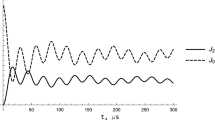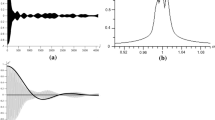Abstract
The free induction decay (FID) is investigated for zigzag (alternating) spin chains in the approximation of the nearest neighbor interactions. The dependence of the FID on the ratio of dipolar coupling constants (the parameter of dimerization) is also studied. Possible comparison of the obtained results with the experimental data for proton zigzag chains in a single crystal of hambergite is discussed.





Similar content being viewed by others
References
N. Bloembergen, E.M. Purcell, R.V. Pound, Phys. Rev. 73, 679 (1948)
A. Abragam, The Principles of Nuclear Magnetism (Clarendon Press, Oxford, 1970)
R. Ernst, G. Bodenhausen, A. Wokaun, Principles of NMR in One and Two Dimensions (Clarendon Press, Oxford, 1987)
L.D. Landau, E.M. Lifshitz, Statistical Physics (Pergamon Press, Oxford, 1980)
P.W. Anderson, P.R. Weiss, Rev. Mod. Phys. 25, 269 (1953)
P.W. Anderson, P.R. Weiss, J. Phys. Soc. Jpn. 9, 316 (1954)
I.J. Lowe, R.E. Norberg, Phys. Rev. 107, 46 (1957)
G.W. Parker, F. Lado, Phys. Rev. B 8, 3081 (1973)
S.J.K. Jensen, O. Platz, Phys. Rev. B 7, 31 (1973)
A.A. Lundin, JETP 83, 759 (1996)
B.V. Fine, Phys. Rev. Lett. 79, 4673 (1997)
A.A. Lundin, V.E. Zobov, JETP 127, 305 (2018)
G.A. Starkov, B. Fine, Phys. Rev. B 101, 024428 (2020)
E.B. Fel’dman, A.K. Khitrin, Zh. Eks, Teor. Fiz. 98, 967 (1990)
K. Tsiberkin, T. Belozerova, V. Henner, Eur. Phys. J. B 92, 140 (2019)
K. Tsiberkin, J. Exp. Theor. Phys. 127, 1059 (2018)
U. Haeberlen, J.S. Waugh, Phys. Rev. 175, 453 (1968)
J. Baum, M. Munowitz, A.N. Garroway, A. Pines, J. Chem. Phys. 83(5), 2015 (1985)
S.I. Doronin, I.I. Maksimov, E.B. Fel’dman, J. Exp. Theor. Phys. 91(3), 597 (2000)
G.A. Bochkin, E.B. Fel’dman, S.G. Vasil’ev, Phys. Lett. A 383, 2993 (2019)
G.A. Bochkin, E.B. Fel’dman, E.I. Kuznetsova, I.D. Lazarev, S.G. Vasil’ev, V.I. Volkov, J. Magn. Reson. 319, 106816 (2020)
E.B. Fel’dman, M.G. Rudavets, JETP Lett. 81, 47 (2005)
E.I. Kuznetsova, E.B. Fel’dman, JETP 102, 882 (2006)
M. Goldman, Spin Temperature and Nuclear Magnetic Resonance in Solids (Clarendon Press, Oxford, 1970)
H.B. Cruz, L.L. Goncalves, J. Phys. C Solid State Phys. 14, 2785 (1981)
P. Jordan, E. Wigner, Z Phys. 47, 631 (1928)
G. Cho, J.P. Yesinovski, J. Phys. Chem. 100(39), 15716–15725 (1996)
G.A. Bochkin, E.B. Fel’dman, I.D. Lazarev, A.A. Samoilenko, S.G. Vasil’ev, J. Magn Reson. 301, 10–18 (2019)
A. Abramovitz, I.A. Stegun, Handbook of Mathematical Functions (Hemisphere, New York, 1987)
Funding
The work was performed as a part of a state task, State Registration No. AAAA-A19-119071190017-7. This work was partially supported by the Russian Foundation for Basic Research (project No. 20-03-00147).
Author information
Authors and Affiliations
Corresponding author
Ethics declarations
Conflict of interest
The authors declare no conflict of interest.
Additional information
Publisher's Note
Springer Nature remains neutral with regard to jurisdictional claims in published maps and institutional affiliations.
Appendix
Appendix
The long-time asymptotic behavior of the FID of Eq. (18)
We rewrite \(G(D_1t)\) of Eq. (18) as follows:
The extremal points of the radical in (21) are:
Expanding the expression under the radical in Taylor series in the vicinity of \(x_1=0\), one can obtain:
Analogously, in the vicinity of \(x_2=\pi /2\) (\(x=\pi /2+y\)), one finds:
Since the main contributions to \(G(D_1t)\) are due to the vicinity of the extrema, one can write:
Since the main contribution to the integrals of Eq. (25) comes from the vicinity of \(z=0\), it is legitimate to set the integration limits to infinity. Using the value of the Fresnel integrals [29]:
one can obtain from Eq. (25):
Equation (27) can be rewritten as follows:
After simple trigonometric transformations in Eq. (28), one obtains finally:
Rights and permissions
About this article
Cite this article
Vasil’ev, S.G., Fedorova, A.V. & Fel’dman, E.B. Free Induction Decay in Zigzag Spin Chains in a Multi-pulse NMR Experiment. Appl Magn Reson 52, 831–842 (2021). https://doi.org/10.1007/s00723-021-01325-2
Received:
Revised:
Accepted:
Published:
Issue Date:
DOI: https://doi.org/10.1007/s00723-021-01325-2




